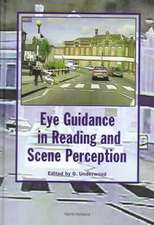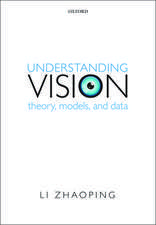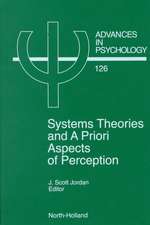Cognitive Contributions to the Perception of Spatial and Temporal Events: Advances in Psychology, cartea 129
Editat de G. Aschersleben, T. Bachmann, J. Müsseleren Limba Engleză Hardback – 17 noi 1999
Din seria Advances in Psychology
- 18%
 Preț: 950.00 lei
Preț: 950.00 lei - 18%
 Preț: 985.11 lei
Preț: 985.11 lei - 15%
 Preț: 457.35 lei
Preț: 457.35 lei - 23%
 Preț: 683.48 lei
Preț: 683.48 lei - 23%
 Preț: 675.31 lei
Preț: 675.31 lei - 23%
 Preț: 676.64 lei
Preț: 676.64 lei - 5%
 Preț: 839.37 lei
Preț: 839.37 lei - 5%
 Preț: 834.81 lei
Preț: 834.81 lei - 23%
 Preț: 668.19 lei
Preț: 668.19 lei - 34%
 Preț: 317.98 lei
Preț: 317.98 lei - 23%
 Preț: 674.72 lei
Preț: 674.72 lei - 20%
 Preț: 1422.35 lei
Preț: 1422.35 lei - 27%
 Preț: 737.53 lei
Preț: 737.53 lei - 20%
 Preț: 1519.06 lei
Preț: 1519.06 lei - 5%
 Preț: 1542.08 lei
Preț: 1542.08 lei - 27%
 Preț: 1020.01 lei
Preț: 1020.01 lei - 27%
 Preț: 1127.58 lei
Preț: 1127.58 lei - 27%
 Preț: 1330.32 lei
Preț: 1330.32 lei - 27%
 Preț: 998.93 lei
Preț: 998.93 lei - 27%
 Preț: 1300.14 lei
Preț: 1300.14 lei - 27%
 Preț: 1299.87 lei
Preț: 1299.87 lei - 27%
 Preț: 1080.20 lei
Preț: 1080.20 lei - 27%
 Preț: 1076.26 lei
Preț: 1076.26 lei - 27%
 Preț: 1075.55 lei
Preț: 1075.55 lei - 27%
 Preț: 1078.09 lei
Preț: 1078.09 lei - 27%
 Preț: 763.84 lei
Preț: 763.84 lei - 27%
 Preț: 908.62 lei
Preț: 908.62 lei - 27%
 Preț: 862.90 lei
Preț: 862.90 lei - 27%
 Preț: 770.45 lei
Preț: 770.45 lei - 5%
 Preț: 1010.86 lei
Preț: 1010.86 lei - 23%
 Preț: 713.55 lei
Preț: 713.55 lei - 23%
 Preț: 616.28 lei
Preț: 616.28 lei - 20%
 Preț: 691.31 lei
Preț: 691.31 lei - 23%
 Preț: 628.12 lei
Preț: 628.12 lei - 23%
 Preț: 653.33 lei
Preț: 653.33 lei - 27%
 Preț: 1382.65 lei
Preț: 1382.65 lei - 27%
 Preț: 1134.35 lei
Preț: 1134.35 lei - 23%
 Preț: 620.13 lei
Preț: 620.13 lei - 23%
 Preț: 651.55 lei
Preț: 651.55 lei - 23%
 Preț: 627.38 lei
Preț: 627.38 lei - 23%
 Preț: 616.73 lei
Preț: 616.73 lei - 27%
 Preț: 1051.14 lei
Preț: 1051.14 lei - 23%
 Preț: 627.09 lei
Preț: 627.09 lei - 27%
 Preț: 1198.73 lei
Preț: 1198.73 lei - 27%
 Preț: 1109.39 lei
Preț: 1109.39 lei - 27%
 Preț: 969.09 lei
Preț: 969.09 lei - 27%
 Preț: 1107.69 lei
Preț: 1107.69 lei - 5%
 Preț: 837.76 lei
Preț: 837.76 lei - 23%
 Preț: 621.30 lei
Preț: 621.30 lei
Preț: 1161.01 lei
Preț vechi: 1590.41 lei
-27% Nou
Puncte Express: 1742
Preț estimativ în valută:
222.23€ • 241.47$ • 186.79£
222.23€ • 241.47$ • 186.79£
Carte tipărită la comandă
Livrare economică 21 aprilie-05 mai
Preluare comenzi: 021 569.72.76
Specificații
ISBN-13: 9780444503251
ISBN-10: 0444503250
Pagini: 1
Ilustrații: 1
Dimensiuni: 156 x 234 x 27 mm
Greutate: 0.84 kg
Editura: ELSEVIER SCIENCE
Seria Advances in Psychology
ISBN-10: 0444503250
Pagini: 1
Ilustrații: 1
Dimensiuni: 156 x 234 x 27 mm
Greutate: 0.84 kg
Editura: ELSEVIER SCIENCE
Seria Advances in Psychology
Cuprins
Part and chapter headings: Cognitive Contributions to the Perception of Spatial Events a) Action-Oriented Views. Separate Representations of Visual Space for Perception and Visually Guided Behavior (B. Bridgeman). On the Perception of Position (A.H.C. Van der Heijden et al.). Space Perception and Intended Action (P. Wolff). Cognition and Spatial Perception: Production of Output or Control of Input? (J. Scott Jordan). Motor Determinants of a Unified World Perception (J. Paillard). How Independent from Action Control is Perception? An Event-Coding Account for More Equally-Ranked Crosstalks (J. Müsseler). Cognitive Contributions to the Perception of Spatial Events b) Attention-Oriented Views. Effects of Attention on Length Perception, Gap Detection and Visual Localization. Towards a Theory of Attentional Receptive Fields (Yehoshua Tsal). Twelve Spatiotemporal Phenomena and One Explanation (T. Bachman). Cognitive Contributions to the Perception of Temporal Events. Perceived Timing of Self-Initiated Actions (P. Haggard). Action Timing in an Isochronous Tapping Task. Evidence from Behavioral Studies and Neuroimaging (K. Müller et al.). Reaction Time and Temporal-Order Judgment as Measures of Perceptual Latency: The Problem of Dissociations (P. Jaśkowski). Task-Dependent Timing of Perceptual Events (G. Aschersleben). 40-Hz-Synchronicity Priming of Kanizsa-Figure Detection Demonstrated by a Novel Psychophysical Paradigm (H.J. Müller, M.A. Elliott). Cognitive Contributions to the Perception of Intermodal Events. Ventriloquism: A Case of Crossmodal Perceptual Grouping (P. Bertelson). Meaning, Attention, and the "Unity Assumption" in the Intersensory Bias of Spatial and Temporal Perceptions (R.B. Welch). The Development of Temporal and Spatial Intermodal Perception (D.J. Lewkowicz). Seeing Cries and Hearing Smiles: Crossmodal Perception of Emotional Expressions (B. de Gelder et al.). Indexes.













